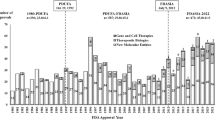Abstract
Although regulatory standards and procedures in Europe have improved following the establishment of the European Medicines Agency (EMEA), the number of major issues with marketing authorization applications for biotechnological products remains high. For example, the pivotal clinical trials of some late-stage failures have been found not to meet the regulatory guidelines of the European Union, and regulators are increasingly concerned that attempts to accelerate the process of biotechnological product development leads to the neglect of important issues. Based on the scientific decisions of the EMEA's major scientific committees, in this article we identify and discuss frequent concerns, and suggest approaches that might enable developers of biotechnological products to avoid these common pitfalls.
This is a preview of subscription content, access via your institution
Access options
Subscribe to this journal
Receive 12 print issues and online access
$209.00 per year
only $17.42 per issue
Buy this article
- Purchase on Springer Link
- Instant access to full article PDF
Prices may be subject to local taxes which are calculated during checkout


Similar content being viewed by others
References
Reichert, J. M., Rosensweig, C. J., Faden, L. B. & Dewitz, M. C. Monoclonal antibody successes in the clinic. Nature Biotech. 23, 1073–1078 (2005).
Cavagnaro, J. A. Preclinical safety evaluation of biotechnology-derived pharmaceuticals. Nature Rev. Drug Discov. 1, 469–475 (2002).
Chapman, K., Pullen, N., Graham, M. & Ragan, I. Preclinical safety testing of monoclonal antibodies: the significance of species relevance. Nature Rev. Drug Discov. 6, 120–126 (2007).
Europeran Commision. Regulation (EC) 726/2004 of the European Parliament and of the Council of 31 March 2004 laying down Community procedures for the authorisation and supervision of medicinal products for human and veterinary use and establishing a European Medicines Agency. Official Journal of the European Union 1, L 136/1–L 136/33 (2004).
European Medicines Agency (EMEA). Refusal Assessment Report for Alpheon. EMEA web site [online], (2006).
European Medicines Agency (EMEA). Refusal Assessment Report for Mycograb. EMEA web site [online], (2007).
European Medicines Agency (EMEA). Scientific Guidelines for Human Medicinal Products/Biologicals Guidelines. EMEA web site [online], (2008).
European Medicines Agency (EMEA). Note for Guidance on Virus Validation Studies: The Design, Contribution and Interpretation of Studies Validating the Inactivation and Removal of Viruses. CPMP/BWP/268/95. EMEA web site [online], (1996).
European Medicines Agency (EMEA). Draft Guideline on Production and Quality Control of Monoclonal Antibodies and Related Substances. EMEA/CHMP/BWP/157653/2007. EMEA web site [online], (2007).
Pignatti, F. et al. The review of drug applications submitted to the European Medicines Evaluation Agency: frequently raised objections, and outcome. Eur. J. Clin. Pharmacol. 58, 573–580 (2002).
European Medicines Agency (EMEA). European Public Assessment Report for Xolair — Scientific Discussion. EMEA web site [online], (2005).
European Medicines Agency (EMEA). European Public Assessment Report for Tysabri — Scientific Discussion. EMEA web site [online], (2006).
Polman, C. H. et al. A randomized, placebo-controlled trial of natalizumab for relapsing multiple sclerosis. N. Engl. J. Med. 354, 899–910 (2006).
Kleinschmidt-DeMasters, B. K. & Tyler K. L. Progressive multifocal leukoencephalopathy complicating treatment with natalizumab and interferon -1a for multiple sclerosis. N. Engl. J. Med. 353, 369–374 (2005).
Langer-Gould, A., Atlas, S. W., Green, A. J., Bollen, A. W. & Pelletier, D. Progressive multifocal leukoencephalopathy in a patient treated with natalizumab. N. Engl. J. Med. 353, 375–381 (2005).
Van Assche, G. et al. Progressive multifocal leukoencephalopathy after natalizumab therapy for Crohn's disease. N. Engl. J. Med. 353, 362–368 (2005).
European Medicines Agency (EMEA). European Public Assessment Report for Tysabri: Conditions Imposed on Member States for Safe and Effective Use. EMEA web site [online], (2007).
Nieminen, O., Kurki, P. & Nordström, K. Differences in product information of biopharmaceuticals in the EU and the USA: implications for product development. Eur. J. Pharm. Biopharm. 60, 319–326 (2005).
Katsnelson, A. FDA and EMEA pool scientific advice. Nature Biotech. 22, 1490–1491 (2004).
Schneider, C. K. Monoclonal antibodies: a special regulatory challenge? WHO Drug Inf. 20, 165–172 (2006).
Acknowledgements
We are grateful to J. Löwer, the President of the PEI and Acting President of the BfArM (German Federal Institute for Drugs and Medical Devices); M. Haase (long-standing previous member of the CHMP); J. Müller-Berghaus (PEI, SAWP); and P. Volkers (PEI, Efficacy Working Party) for support and their helpful and encouraging discussion on the manuscript.
Author information
Authors and Affiliations
Corresponding author
Related links
Rights and permissions
About this article
Cite this article
Schneider, C., Schäffner-Dallmann, G. Typical pitfalls in applications for marketing authorization of biotechnological products in Europe. Nat Rev Drug Discov 7, 893–899 (2008). https://doi.org/10.1038/nrd2728
Issue Date:
DOI: https://doi.org/10.1038/nrd2728
This article is cited by
-
Ethics and the marketing authorization of pharmaceuticals: what happens to ethical issues discovered post-trial and pre-marketing authorization?
BMC Medical Ethics (2020)
-
Analysis of Immunogenicity Data in the Product Information of Biological Drugs: A Need to Report Immunogenicity Data Systematically
BioDrugs (2019)
-
Setting the stage for biosimilar monoclonal antibodies
Nature Biotechnology (2012)
-
Clinical Development of Advanced Therapy Medicinal Products in Europe: Evidence That Regulators Must Be Proactive
Molecular Therapy (2012)
-
Cell therapeutic options in liver diseases: cell types, medical devices and regulatory issues
Journal of Materials Science: Materials in Medicine (2011)



